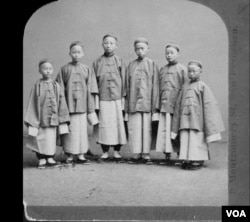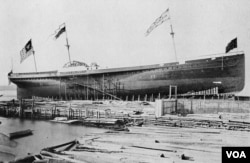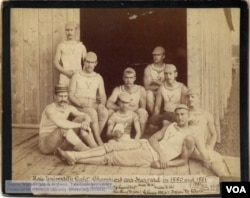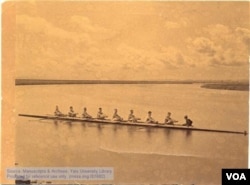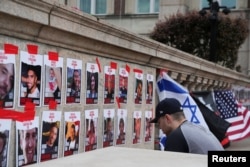Student Union
What Was it Like to be a Chinese Student in 19th Century America?
“This group of boys, dressed in silk gowns, their queues flapping, was too much for New Englanders, be they small-town folk or city dwellers, to ignore. In Springfield, for example, the boys’ dinner at a local hotel was interrupted when an American woman, dining at a nearby table, stood up and wordlessly approached the Chinese youths and started dreamily fondling their queues … They were less amused a few days later when, while visiting Hartford, American children chased them down the street, pushing and shoving each other for a better glimpse of the strange, new breed of humans that had arrived on their shores. … The more fearful among them recalled the horrific stories circulated back home about Americans and their desire to turn the Chinese boys into sideshow curiosities.”
In 1872, when 30 Chinese students arrived on America’s east coast as part of an educational program sponsored by the Chinese government, they attracted quite a bit of attention.
They weren't the first to study in the area though. The first Chinese student ever to receive a degree in the U.S. was Yung Wing, who came to America for high school in 1847 and received his diploma from Yale University in 1852. Yung then spearheaded an educational mission to send 120 Chinese boys to study in the U.S. for 15 years, arriving in dispatches of 30 per year.
What would it have been like to be one of those Chinese students in the 1800s?
Part of the answer can be found in letters and diaries kept by the students, which authors Leil Leibovitz and Matthew Miller used to write a book called Fortunate Sons: The 120 Chinese Boys Who Came to America, Went to School, and Revolutionized an Ancient Civilization.
“We were amazed to find how meticulous these men had been about documenting their lives,” Leibovitz said about writing the book. “So you really just had to open the boxes, which to my amazement and great fortune, no one had thought of doing in the century that passed.”
Yung Wing also published a memoir recounting his experience, as did Li En Fu, one of the 120 to participate in the educational mission.
Here, in their own words, is how Chinese students experienced 19th century America.
How did they apply?
Here’s how students apply today.
Yung Wing wrote in his memoir, My Life in China and America, that he was attending the first English school in China when he got a unique opportunity:
“[Schoolmaster Rev. S.R. Brown] left China in the winter of 1846. Four months before he left, he one day sprang a surprise upon the whole school. He told of his contemplated return to America on account of his health and the health of his family. Before closing his remarks by telling us of his deep interest in the school, he said he would like to take a few of his old pupils home with him to finish their education in the United States … When he requested those who wished to accompany him to the States to signify it by rising, I was the first one on my feet.”
The 120 boys who followed him in 1872 had rather a different experience.
In When I Was a Boy in China Li En Fu recalled, “A school was established at Shanghai to receive candidates, and announcement made that the government had appropriated a large sum or money to educate one hundred and twenty boys in America, who were to be sent in four detachments …”
“… I was taken to the Tung Mim Kuen, or Government School, where I was destined to spend a whole year, preparatory to my American education … It was afternoon, and the Chinese lessons were being recited. … At half-past four o’clock, school was out and the boys, to the number of forty, went forth to play. They ran around, chased each other and wasted their cash on fruits and confections. …
After breakfast the following morning we assembled in the same schoolroom to study our English lessons. The teacher of this branch was a Chinese gentleman who learned his English at Hongkong. The first thing to be done with me was to teach me the alphabet. … It took me two days to learn them. The letter R was the hardest one to pronounce, but I soon learned to give it, with a peculiar roll of the tongue even. … A year thus passed in study and pastime. Sundays were given to us to spend as holidays.
It was in the month of May when we were examined in our English studies and the best thirty were selected to go to America, their proficiency in Chinese, their general deportment and their record also being taken into account.”
According to Ning Qian in his book Chinese Students Encounter America, “The parents of the first group of 30 boys sent to America in 1872 had to sign an agreement to 'accept the will of destiny should the child become ill or die' during the study.”
How did they get there?
Here’s how it’s done today.
In the 1800s, the only way to get from China to America would have been by boat. Yung described his journey like this:
“The tops of the masts and ends of the yards were tipped with balls of electricity. The strong wind was howling and whistling behind us like a host of invisible Furies. The night was pitch dark and the electric balls dancing on the tips of the yards and tops of the masts, back and forth and from side to side like so many infernal lanterns in the black night, presented a spectacle never to be forgotten by me. … We landed in New York on the 12th of April, 1847, after a passage of ninety-eight days of unprecendented fair weather.”
Li arrived by boat to San Francisco, which “impressed my young imagination with its lofty buildings – their solidity and elegance. … But the 'modern conveniences' of gas and running water and electric bells and elevators were what excited wonder and stimulated investigation.”
To get to New England, where he was going to study, he had to take a train – the transcontinental railroad, completed only a few years earlier (and built, ironically, largely by Chinese laborers):
“Nothing occurred on our Eastward journey to mar the enjoyment of our first ride on the steamcars – excepting a train robbery, a consequent smash-up of the engine, and the murder of the engineer. We were quietly looking out of the windows and gazing at the seemingly interminable prairies when the train suddenly bounded backward, then rushed forward a few feet, and, then meeting some resistance, started back again. Then all was confusion and terror. Pistol-shots could be made out above the cries of frightened passengers. Women shrieked and babies cried. Our party, teachers and pupils, jumped from our seats in dismay and looked out through the windows for more light on the subject. What we saw was enough to make our hair stand on end. Two ruffianly men held a revolver in each hand and seemed to be taking aim at us from the short distance of forty feet or thereabouts. Our teachers told us to crouch down for our lives. …
In half an hour the agony and suspense were over. A brakeman rushed through with a lamp in his hand. He told us that the train had been robbed of its gold bricks, by five men, three of whom, dressed like Indians, rifled the baggage car while the others held the passengers at bay; that the engine was hopelessly wrecked, the engineer killed; that the robbers had escaped on horseback with their booty; and that men had been sent to the nearest telegraph station to “wire” for another engine and a supply of workmen. One phase of American civilization was thus indelibly fixed upon our minds.”
When he finally arrived in Springfield, Massachusetts, Li was assigned to a host mother, who “put her arms around me and kissed me. This made the rest of the boys laugh, and perhaps I got rather red in the face ; however, I would say nothing to show my embarrassment. But that was the first kiss I ever had had since my infancy.”
What were their studies like?
Here’s what it’s like today.
When Yung graduated from his American high school, he applied to continue his studies at Yale University. He found the academic requirements there fairly stringent:
“How I got in, I do not know, as I had had only fifteen months of Latin and twelve months of Greek, and ten months of mathematics … But I was convinced I was not sufficiently prepared, as my recitations in the class-room clearly proved. Between the struggle of how to make ends meet financially and how to keep up with the class in my studies, I had a pretty tough time of it. I used to sweat over my studies till twelve o’clock every night the whole Freshman year.”
Yung wrote to a friend, “One has no time to think or analyze except study. There is also great excitement among the students themselves…mental excitement … I enjoy its influence very much.”
The boys who came as part of the educational mission lived with American families during their high school years and, according to Leibovitz and Miller, student Y.T. Woo called his host mother:
“... a strict disciplinarian. When we held our knives and forks too low at meals, she would correct us. When she heard us talking in our rooms in the attic after nine or ten p.m., she would shout from below, ‘Boys, stop talking, it is time to sleep.’”
The students were required to attend classes in Chinese language and culture on top of their normal academics, including during summer holidays. But it wasn’t all work. Leibovitz and Miller quoted an American classmate as saying that “at dances and receptions, the fairest and most sought-out belles invariably gave the swains from the Orient the preference.”
And an American student told this story about classmate Chung Mun Yew’s time as coxswain of Yale’s crew team:
“He was told he must swear at the oarsmen to make them row their best; for he usually sat in his place in silence. Swearing did not come naturally to him, for he was grave and impassive; but finally, being told he must curse them, he would, at the most unexpected moments, and without any emphasis mechanically utter the monosyllable “damn!” whereat the crew became so helpless with laughter, they begged him to desist.” (Leibovitz and Miller)
What was it like when they went home?
Here's what it's like today.
After being in America for over 6 years, Yung experienced some serious culture shock on the way home:
“As we approached Hong Kong, a Chinese pilot boarded us. The captain wanted me to ask him whether there were any dangerous rocks and shoals nearby. I could not for the life of me recall my Chinese in order to interpret for him … So the skipper and Macy, and a few other persons who were present at the time, had the laugh on me, who, being a Chinese, yet was not able to speak the language.”
And, like many modern students, when Yung saw his mother again after so much time away, he had to endure some motherly nagging:
“The interview seemed to give her great comfort and satisfaction. She seemed very happy over it. After it was ended, she looked at me with a significant smile and said, 'I see you have already raised your mustaches. You know you have a brother who is much older than you are; he hasn’t grown his mustaches yet. You must have yours off.' I promptly obeyed her mandate, and as I entered the room with a clean face, she smiled with intense satisfaction, evidently thinking that with all my foreign education, I had not lost my early training of being obedient to my mother.”
The return of Li En Fu and the other boys who participated in the educational mission was a bit different. The politics of the day led to them being recalled to China early, where, upon their arrival, they spent several days in prison on suspicion of being spies.
Books:
Leil Leibovitz and Matthew Miller, Fortunate Sons: The 120 Chinese Boys Who Came to America, Went to School, and Revolutionized an Ancient Civilization
Yung Wing (sometimes written Wing Yung), My Life in China and America
Yan Phou Lee (different spelling for Li En Fu), When I Was a Boy in China
Ning Qian (trans. T.K. Chu), Chinese Students Encounter America
See all News Updates of the Day
- By VOA News
What types of graduate student housing are there?
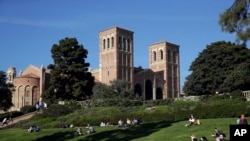
Anayat Durrani of the US News & World Report breaks down the options. (April 2024)
Pro-Palestinian protests spread on US university campuses
U.S. university campuses are seeing pro-Palestinian protests daily. Students are demonstrating against the Israel-Hamas war in Gaza and demanding that humanitarian aid be allowed to flow into the territory. VOA’s Veronica Balderas Iglesias reports.
US police clash with students who demand colleges cut financial ties to Israel
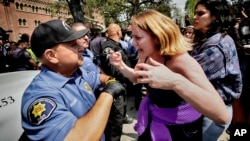
Police tangled with student demonstrators in the U.S. states of Texas and California while new encampments sprouted Wednesday at Harvard and other colleges as school leaders sought ways to defuse a growing wave of pro-Palestinian protests.
At the University of Texas at Austin, hundreds of local and state police — including some on horseback and holding batons — clashed with protesters, pushing them off the campus lawn and at one point sending some tumbling into the street. At least 20 demonstrators were taken into custody at the request of university officials and Texas Governor Greg Abbott, according to the state Department of Public Safety.
A photographer covering the demonstration for Fox 7 Austin was arrested after being caught in a push-and-pull between law enforcement and students, the station confirmed. A longtime Texas journalist was knocked down in the mayhem and could be seen bleeding before police helped him to emergency medical staff who bandaged his head.
At the University of Southern California, police got into a back-and-forth tugging match with protesters over tents, removing several before falling back. At the northern end of California, students were barricaded inside a building for a third day at California State Polytechnic University, Humboldt. The school shut down campus through the weekend and made classes virtual.
Harvard University in Massachusetts had sought to stay ahead of protests this week by limiting access to Harvard Yard and requiring permission for tents and tables. That didn't stop protesters from setting up a camp with 14 tents Wednesday following a rally against the university's suspension of the Harvard Undergraduate Palestine Solidarity Committee.
Students protesting the Israel-Hamas war are demanding schools cut financial ties to Israel and divest from companies enabling its monthslong conflict. Dozens have been arrested on charges of trespassing or disorderly conduct. Some Jewish students say the protests have veered into antisemitism and made them afraid to set foot on campus.
Columbia University averted another confrontation between students and police earlier in the day. The situation there remained tense, with campus officials saying it would continue talks with protesters for another 48 hours.
On a visit to campus, U.S. House Speaker Mike Johnson, a Republican, called on Columbia University President Minouche Shafik to resign "if she cannot bring order to this chaos."
"If this is not contained quickly and if these threats and intimidation are not stopped, there is an appropriate time for the National Guard," he said.
Shafik had set a midnight Tuesday deadline to reach an agreement on clearing an encampment, but the school extended negotiations, saying it was making "important progress."
On Wednesday evening, a Columbia spokesperson said rumors that the university had threatened to bring in the National Guard were unfounded. "Our focus is to restore order, and if we can get there through dialogue, we will," said Ben Chang, Columbia's vice president for communications.
Columbia graduate student Omer Lubaton Granot, who put up pictures of Israeli hostages near the encampment, said he wanted to remind people that there were more than 100 hostages still being held by Hamas.
"I see all the people behind me advocating for human rights," he said. "I don't think they have one word to say about the fact that people their age, that were kidnapped from their homes or from a music festival in Israel, are held by a terror organization."
Harvard law student Tala Alfoqaha, who is Palestinian, said she and other protesters want more transparency from the university.
"My hope is that the Harvard administration listens to what its students have been asking for all year, which is divestment, disclosure and dropping any sort of charges against students," she said.
Columbia encampment inspires others
Police first tried to clear the encampment at Columbia last week, when they arrested more than 100 protesters. The move backfired, acting as an inspiration for other students across the country to set up similar encampments and motivating protesters at Columbia to regroup.
On Wednesday about 60 tents remained at the Columbia encampment, which appeared calm. Security remained tight around campus, with identification required and police setting up metal barricades.
Columbia said it had agreed with protest representatives that only students would remain at the encampment and they would make it welcoming, banning discriminatory or harassing language.
On the University of Minnesota campus, a few dozen students rallied a day after nine protesters were arrested when police took down an encampment in front of the library. U.S. Representative Ilhan Omar, whose daughter was among the demonstrators arrested at Columbia last week, attended a protest later in the day.
A group of more than 80 professors and assistant professors signed a letter Wednesday calling on the university's president and other administrators to drop any charges and to allow future encampments without what they described as police retaliation.
They wrote that they were "horrified that the administration would permit such a clear violation of our students' rights to freely speak out against genocide and ongoing occupation of Palestine."
Netanyahu encourages police response
Israeli Prime Minister Benjamin Netanyahu lashed out at the pro-Palestinian demonstrations on U.S. college campuses in a video statement released Wednesday, saying the response of several university presidents has been "shameful" and calling on state, local and federal officials to intervene.
Students at some protests were hiding their identities and declined to identify themselves to reporters, saying they feared retribution. At an encampment of about 40 tents at the heart of the University of Michigan's campus in Ann Arbor, almost every student wore a mask, which was handed to them when they entered.
The upwelling of demonstrations has left universities struggling to balance campus safety with free speech rights. Many long tolerated the protests, but are now doling out more heavy-handed discipline, citing safety concerns.
At New York University this week, police said 133 protesters were taken into custody and all had been released with summonses to appear in court on disorderly conduct charges. More than 40 protesters were arrested Monday at an encampment at Yale University.
Columbia University demonstrators in talks with administration officials
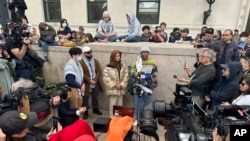
Officials at Columbia University were continuing talks Wednesday with student demonstrators from the Gaza Solidarity Encampment as the protest reaches a full week.
At 9:41 p.m. Tuesday, university President Nemat “Minouche” Shafik sent an email to the Columbia community setting a midnight deadline for an agreement to be reached about dismantling the encampment and dispersing the protesters.
“I very much hope these discussions are successful,” she wrote. “If they are not, we will have to consider alternative options for clearing the West Lawn and restoring calm to campus so that students can complete the term and graduate.”
As midnight passed, Columbia University Apartheid Divest posted a statement on X saying, “We refuse to concede to cowardly threats and blatant intimidation by university administration. We will continue to peacefully protest.”
The statement also said the university had threatened to call the National Guard. But after visiting the university earlier in the week, New York Governor Kathy Hochul said Tuesday she had no plans to deploy the National Guard.
As midnight approached on Tuesday, a student organizer announced that the deadline had been extended to 8 a.m. Wednesday.
At 4:09 a.m., the Office of the President sent an email saying the discussion deadline would be extended for 48 hours, given the constructive dialogue, and the university would report back on progress.
The email announced that leaders of the student encampment had agreed to remove a significant number of tents, get non-Columbia affiliates to leave the encampment and comply with New York Fire Department requirements. They also agreed to ensure that the encampment is “welcome to all” and to prohibit “discriminatory or harassing language.”
This development comes nearly a week after more than 100 students were arrested at the school on April 18, after Shafik authorized police to clear away protesters. Some of the students received suspension notices from the school.
Columbia’s action prompted an onslaught of pro-Palestinian demonstrations at other universities and responses from faculty and politicians.
Students at other campuses, such as Yale, Stanford and New York University, have also rallied around the Palestinian cause, calling for their universities to divest from companies with ties to Israel and for a cease-fire in Gaza. Many also have put up tent encampments on their campuses. About 150 students and faculty were arrested at New York University Monday night.
Columbia also announced Tuesday morning that classes on the Morningside main campus, where the protests are taking place, will be offered in a hybrid format for the remainder of the spring semester. The last day of classes is April 29.
- By VOA News
Paper: International students faced extra pandemic challenges
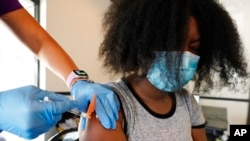
Astrobites, which describes itself as "a daily astrophysical literature journal written by graduate students in astronomy since 2010," focuses on the challenges international students faced during the COVID-19 pandemic.
It examines a paper published in the Journal of Comparative & International Higher Education entitled The Impact of the COVID-19 Pandemic on International Students in a Public University in the United States: Academic and Non-academic Challenges.
Read the Astrobites article here. (April 2024)





